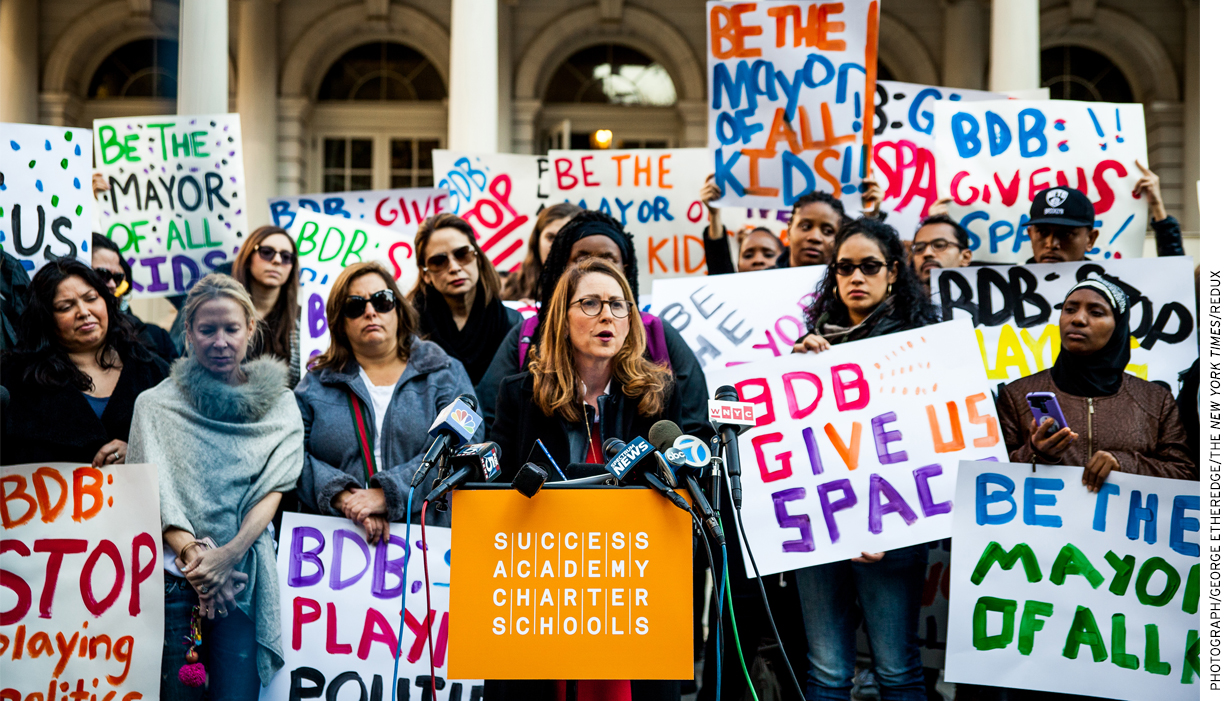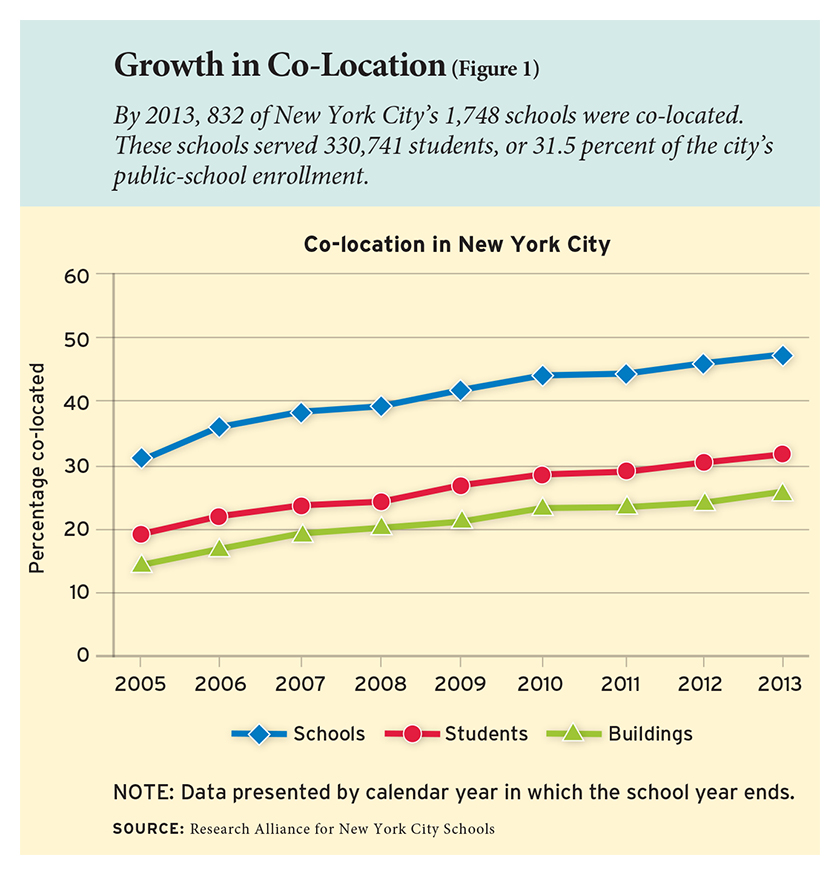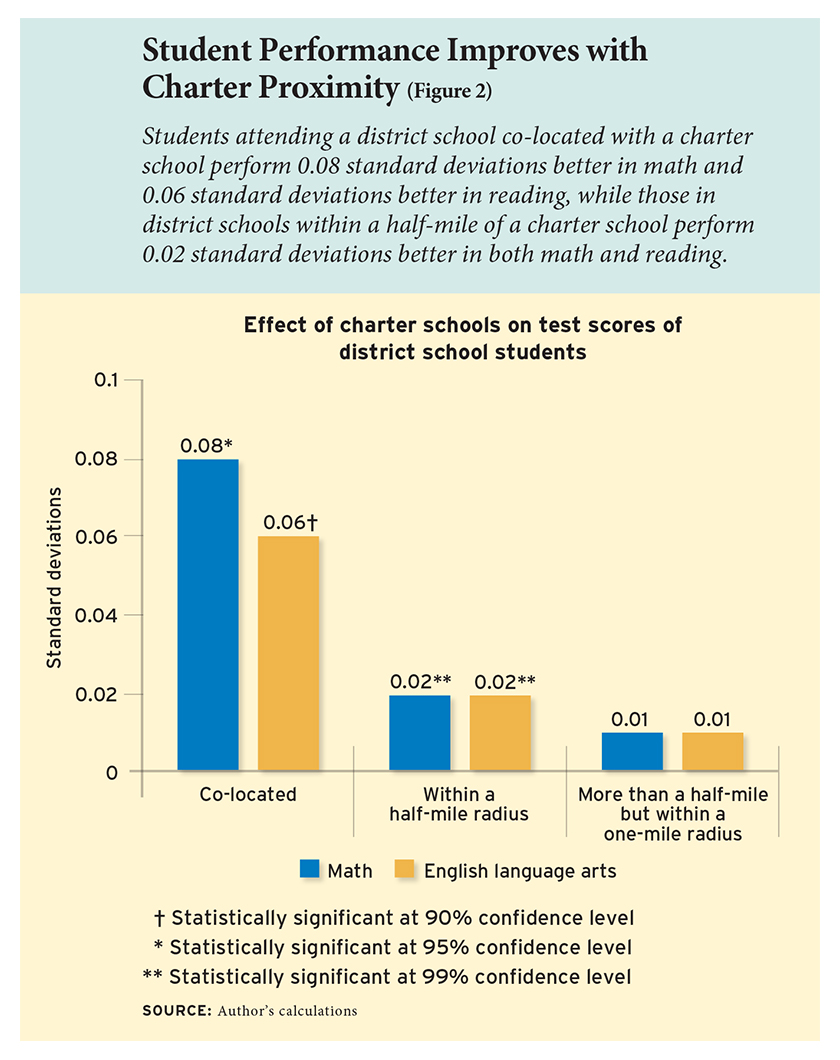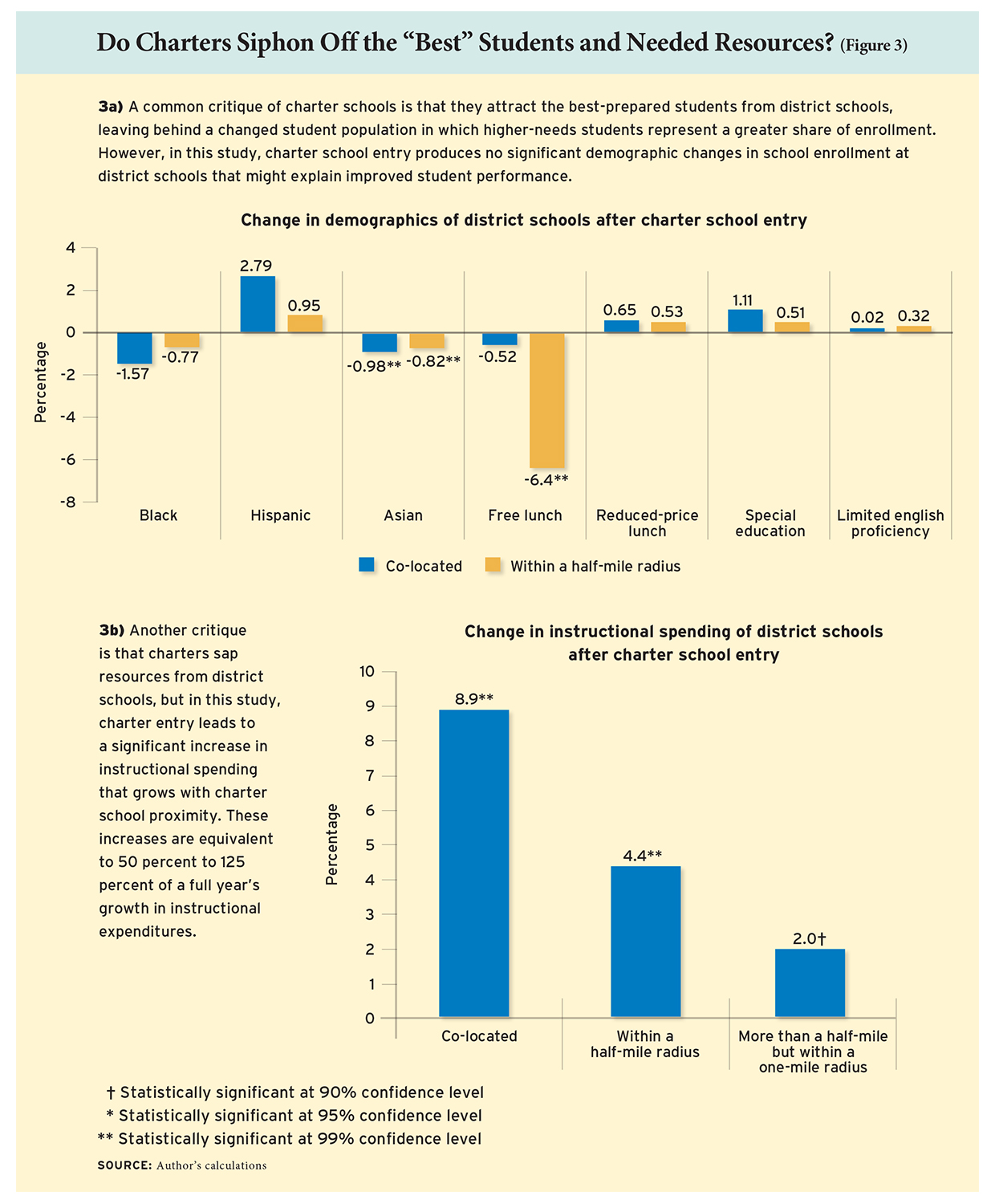
Charter schools represent a small share of the national education market: just 6.2 percent of all public schools and 4.6 percent of all students. But their rapid growth over the past two decades has captured an outsized measure of public attention, especially in communities where district and charter schools operate side by side.
Take New York City’s Success Academy, a network of 46 schools led by Eva Moskowitz. Despite long waiting lists and well-documented academic gains for Success students, leaders are in a near-constant battle with city education officials for the space in under-utilized public-school buildings that will allow their programs to continue to grow. Most recently, Moskowitz issued a high-profile rejection of a city plan to house new students from six middle-school programs in two sites, which she and local newspaper editorial boards criticized as an unstable, temporary fix that would force families to travel too far to school.
These pitched battles often follow a similar script about the potential “spillover effects” of public charter schools on non-charter students, one which has informed political campaigns, protests, and even lawsuits. Advocates argue that charter expansion not only meets the needs of students currently on lengthy waiting lists, but also can improve performance at all public schools due to increased competition and opportunities to innovate and share successful strategies. Critics say that charters sap resources and siphon off motivated students from under-resourced district schools, which are often already serving poor and low-performing students. The debate is especially heated in communities that practice co-location, in which charters and district schools operate in the same building and share common spaces like libraries and gymnasiums.
To shed light on the question of spillover effects, I use data from New York City to estimate the effects of charter schools on students in two types of nearby district schools: those in the same neighborhood, and those that are co-located (in the same building). I find that students in district schools do better when charters open nearby: students in these schools earn higher scores on reading and math tests and are less likely to repeat a grade. The closer the schools, the larger the effect: co-location increases test scores by 0.08 standard deviations in math and 0.06 in reading.
These findings show that communities can expand charter schools to meet growing demand without putting district schools at risk of instability or failure. Far from an existential threat to their district-school neighbors, public charter schools can benefit not only their own students but also those in other programs down the street—or hallway.
Data
The impact of public charter schools on their own students’ academic performance is by now well-documented, showing wide variability overall but also clear evidence of large positive effects in many urban centers, including New York City. There is far less research, however, regarding the potential impacts that charters have on the academic performance of neighboring non-charter students.
 Prior studies examining this question have focused on the district level or explored the effects of charter schools located within several miles of a traditional public school. But if the spillover effects of urban charter schools on district schools are confined to relatively small neighborhoods, then findings from prior analyses may well be underestimates.
Prior studies examining this question have focused on the district level or explored the effects of charter schools located within several miles of a traditional public school. But if the spillover effects of urban charter schools on district schools are confined to relatively small neighborhoods, then findings from prior analyses may well be underestimates.
I look at New York City, the nation’s largest school district, where both charter and co-located schools have increased over the past decade. By 2013, charter schools accounted for 11 percent of all city schools, up from 2 percent about a decade earlier. Some 60 percent of all charter schools are in co-located buildings; by contrast, 47 percent of all public schools in New York City were co-located in 2013 (see Figure 1).
My study is based on multiple sources of data from the New York City Department of Education, including student-level administrative data, school report cards, school expenditure reports, and school-environment surveys, as well as school-level data from the federal government’s Common Core of Data. The data span 14 years, from 1996–97 to 2009–10, and include students in grades 3–5 attending a district school located in the same community school district (a sub-unit of a district) where a charter school has at least one overlapping grade. I focus on elementary schools because charter school penetration was (and still is) highest in the elementary grades; I define elementary schools as any school that includes 4th grade.
Public charter schools are not randomly located—neighborhoods where charters have opened serve greater numbers of low-income students and students of color, who have lower average scores on annual statewide tests in reading and math compared to their wealthier, whiter peers in districts without charter schools. I therefore restrict my analysis to students in community school districts that include both district and charter schools.
I also focus on students with at least two years of scores on annual statewide tests in math and reading, to account for past performance and measure their progress over time. This results in a total of 876,731 unique students attending 584 unique elementary schools. The data included students’ race, nativity, immigration history, grade, borough of residence, attendance, eligibility for free and reduced-price school meals, and participation in limited English proficiency (LEP) and special education programs.
I measure whether there is a charter school in a district school’s “neighborhood” by drawing a one-mile radius around each district school. This neighborhood measure meets two key criteria: it is large enough so that it is plausible for other schooling options to exist within its boundaries, and it is small enough so that it excludes schools that a student is not likely to attend. The one-mile radius matches the district’s official definition of walking distance for students in grades 3–6, and city data shows that 75 percent of elementary charter-school students live within one mile of their school.
Finally, due to preferential admissions policies in charter schools, I restrict this neighborhood measure to include only district schools and charter schools located in the same community school district. New York State law has required charter schools to grant admissions preference to students living in the local community school district since 2007–08; prior to that, many charters followed this practice voluntarily.
Methodology
To assess the spillover effect of charter schools on students at district schools, I analyze how individual students’ test scores, attendance, and grade progression change in response to exposure to a charter school. Simply comparing performance based on whether a student’s district school is or is not located within one mile of a charter school could be misleading given differences in where charter schools are located. Instead, I take advantage of changes over time in the presence of nearby charter schools due to new charters opening.
I use the timing of entry of charter schools across the neighborhoods where they open, and their precise locations, to identify their effect using two approaches. I compare the outcomes of students at district schools after a charter school opens nearby to the outcomes of students in the same schools before a charter opened. In addition, I compare the outcomes of students in district schools that are located closer to a charter school with the outcomes of students in the same schools when the nearest charter was farther away.
Limiting comparisons to students who attended the same district schools accounts for all features of schools that do not change over time, such as their spatial attributes (that is, whether nearby buildings are suitable for housing a charter school). I control for other factors that affect all NYC public schools in a given year, such as the appointment of a new chancellor or curriculum changes, and I use prior-year test scores to capture students’ ability and control for previous school and family effects.
I capture individual students’ exposure to charter schools in multiple ways. The most basic is whether there is any charter school located within one mile of a student’s district school. I then analyze results based on the distance between each district school and the nearest charter school, and whether a district school is co-located in the same building as a charter school.
Because students move frequently, including to neighborhoods with higher-performing zoned district schools, I consider each student’s district school to be the first school where they are enrolled. That is, if a student is first observed attending a district school located in a community school district included in this analysis, that student is considered exposed to a charter school in all years after a charter school opens within one mile of that district school, whether or not the student exits to attend another district school not located near a charter school.
However, if a student exits a district school to attend a charter school, he or she is excluded from the analysis. This allows me to address both switching between district schools and switching to a charter school in response to charter entry. It also focuses on changes in individual student performance rather than on school composition over time, since the performance of each student is “fixed” with his or her original school and compared to his or her original classmates throughout their careers at NYC district schools.
Results
 Students whose schools are near charters do better, and the closer the charter school is, the better these students do. Students attending a co-located district school perform 0.08 standard deviations better in math and 0.06 standard deviations better in reading. Students in district schools within a half mile of a charter school perform 0.02 standard deviations higher in both math and reading (see Figure 2).
Students whose schools are near charters do better, and the closer the charter school is, the better these students do. Students attending a co-located district school perform 0.08 standard deviations better in math and 0.06 standard deviations better in reading. Students in district schools within a half mile of a charter school perform 0.02 standard deviations higher in both math and reading (see Figure 2).
There are no significant spillover effects on students in district schools located more than a half mile away from the nearest charter school. When I look within a three-mile radius, I find no evidence of spillover effects on test scores of students at district schools, positive or negative.
To be sure, scores on standardized tests do not represent the full range of potential charter-school spillover effects. I also find large and meaningful reductions in the percentage of students at district schools who are required to repeat a grade as a result of charter school entry. Students in co-located schools are 1.2 percentage points less likely to be retained, students at schools within a half mile are 1.0 percentage point less likely to be retained, and students at schools between a half mile and one mile from a charter school are 0.6 percentage points less likely to be retained compared to students with no charter school in the neighborhood. Although these effects may seem small in magnitude, they translate into meaningful reductions—between 20 and 40 percent off the baseline grade-retention rate of 3.0 percent among students in this sample.
It also appears that charter schools may have small, negative effects on absenteeism at nearby district schools. In the sample, the average rate of student absences is 8 percent. That rate decreases by 0.3 percentage points in co-located district schools and by roughly half as much in district schools between a half mile and one mile of a charter school.
I next look at whether different types of charter schools generate different spillover effects—and whether the effects of charter school exposure vary across student groups. These analyses examine how the sizes of the overall effects reported above vary based on the density of nearby charter schools, the quality of the charter school (based on test-score performance and charter operator), and a range of student characteristics.
First, I find that as charter density grows, so do the effects. Students in district schools with three or more charter schools within a one-mile radius perform significantly better in math than students with just one charter in the neighborhood. They are also significantly less likely to be retained.
Second, there is suggestive evidence that spillover effects are larger if the charter school appears to be of high quality, which I define as either having high average scores on annual 4th-grade math and reading exams or being operated by an established, respected charter management organization such as KIPP, Success Academy, or Uncommon Schools. Unlike the results for all charter schools, where students in co-located schools experience the most positive effects, the largest effect in reading is for students at traditional public schools located within a half-mile radius of a high-quality charter. This may be because having a charter school in the same building places the same amount of pressure on a district school regardless of charter performance, whereas those district schools located near to but not in the same building as a charter feel stronger pressure from high-performing charters.
Third, I assess the effect of charter proximity on historically underperforming students at district schools, a population often referenced in debates over charter expansion. In math, charter school entry increases performance among all subgroups of students at district schools except Hispanic students and students classified as LEP, who experience no effects; Asian students only experience a significant positive effect in math in district schools located within a half-mile radius. In reading, Hispanic students experience significant gains, whereas most other subgroups show slightly smaller positive effects.
I find that charter schools may be particularly beneficial to students who are poor or eligible for special education services, a finding which is perhaps more striking for these particularly at-risk groups. The results indicate that charter schools tend to increase or, at the very least, do not harm the performance of at-risk student populations in nearby district schools.
I check the validity of my analysis in two ways. First, I investigate the possibility that charters choose where to open based on existing performance trends at district schools, such as opening
near a school where performance is on the decline. Such a pattern would bias my results, but I find no evidence of significantly different performance trends in either math or reading prior to a charter opening in the neighborhood.
Second, I verify that my analysis shows spillover effects of charters, rather than a potential performance bump due to students switching between district and charter schools in their neighborhoods. I do this by looking at the sample of students who are continuously enrolled in a district school between grades 3 and 5 in order to exclude students coming from and going to other schools; their results are nearly identical to, if not slightly larger than, the effects on the full sample. I also find that charter school entry has only a small impact on the probability of students exiting nearby district schools.

How Do Effects Spill Over?
I investigate a number of possible mechanisms by which charter schools might influence students at district schools by examining school-level data and survey results from parents and teachers. Although these estimates provide descriptive rather than causal evidence, they serve as helpful context to educators and policymakers looking to understand these relationships.
One common critique of charter schools is that they attract the best-prepared students from district schools, leaving district schools to serve a higher-need population. My analysis finds no significant changes in school demographics at district schools after charter entry that might explain improved student performance (see Figure 3a). Among district schools within a half-mile and one-mile radius, charter school entry leads to significant decreases in general education enrollment of approximately 16 students per school, on average. In co-located schools, charter school entry leads to a significant decrease of 11.5 special education students; however, there is no change in the overall percentage of special education students at co-located district schools.
Another critique is that charters sap resources from district schools, putting additional stress on neighborhood programs. I find, however, that charter entry leads to a significant increase in instructional spending in district schools that grows with charter school proximity: 8.9 percent for co-located schools, 4.4 percent for schools within a half-mile radius, and 2.0 percent for schools within one mile of a charter school (see Figure 3b). The opening of a charter school leads to small reductions in enrollment at nearby district schools, but does not change the percentage of students from underrepresented minority groups, special education students, or LEP students. This is the case for co-located charter schools as well as for those that open within a half-mile or one-mile radius.
What about adult behavior? Might parents and teachers act differently at district and charter schools, based on varied perceptions of those programs? How might that influence school performance?
To assess parents’ perceptions, I examine data from the NYC school survey, which asks parents about their and their child’s experiences and perceptions of their school. I focus on academic expectations, communication, parental engagement, student engagement, and school safety, finding suggestive evidence that after charter school entry, parents report significantly higher student engagement and parents in co-located schools also report significantly higher perceptions of school safety. Although effects on the other indicators are not statistically significant, in general they are positive and grow in concert with charter school proximity. These results suggest that the improvements in test scores after charter school entry could reflect changes in school practices, such as improving student engagement. Alternatively, higher test scores could reflect a more positive and involved group of parents remaining in district schools.
Finally, I provide the first evidence on how charter school entry may be related to changes in teacher perceptions of practices at district schools along five indexes: academic expectations, communication, engagement, school respect and discipline, and school safety. Similar to those of parents, teacher perceptions are marginally more positive after charter school entry. Teachers in co-located schools report higher levels of academic expectations and more respect and cleanliness, for example. Although there is no significant difference on any of the individual indicators, the sum of responses indicates that teachers’ overall perceptions at a district school improve after a charter school opens nearby. The fact that both parent and teacher perceptions move in the same direction strengthens the case that district schools respond to charter school entry with changes in school practices.

Implications
These findings shed new light on the public debate over the effects of charter schools on non-charter students. Rather than sapping resources and putting students at district schools at a disadvantage, the data in New York City show that students do better when charters open nearby. In particular, students at co-located district schools, where their school shares a building with a charter school, experience the most sharply positive spillover effects. Importantly, the effects of co-location appear to be specific to charter schools, as students in district schools that are co-located with other district schools do not experience similar performance gains.
The survey data suggest that these positive effects may be explained by a combination of increased instructional per-pupil spending and changes in practice, shedding some light on how physical proximity can inspire change. Future research should more fully explore these mechanisms, in particular, the finding of increased per-pupil spending, to determine whether these might be explained by smaller class sizes or changes in the composition of the teaching force at district schools.
But what about students at district schools who are not exposed to charter schools? Do the improvements in performance elsewhere come at a cost to them? My analysis finds no spillover effects on students at district schools within a larger, three-mile radius of a charter school. Further, an examination of trends in citywide performance on math and reading tests between 2000 and 2009, a period of rapid charter expansion, shows that math and reading proficiency continued to increase during those years. Together, this indicates that the positive spillovers of charter schools on nearby students at district schools did not come at the detriment of students across the city.
The implications of this research for policy are twofold. First, charter schools appear to have modest positive effects, or at the very least, no significant negative effects on student performance at district schools nearby. This suggests that rather than capping the number of charter schools, it may be beneficial (and certainly not harmful) to allow for further expansion in NYC. Second, my results indicate that controversial co-location practices may actually be a good policy for both charter and district schools in NYC.
Further research is needed to explore whether performance gains and school-level responses are maintained over the long run and to examine whether charter schools affect students who live nearby in other ways, such as through changes in property values and residential segregation patterns. In addition, the spillover effects of charter schools in NYC found here may reflect particular institutional and contextual factors, such as the relatively small share of city K–8 students attending charters during this period. Future work should examine spillover effects in various institutional contexts and in districts where charter schools have a larger market share, such as New Orleans, Philadelphia, or Denver.
But it is clear that the typical arguments that drive charter-related controversies and public debate fail to capture the ways in which district and charter schools affect one another. More research is needed to better inform the conditions policymakers can set to ensure all schools can operate to the benefit of all students.
Sarah A. Cordes is assistant professor of policy, organizational, and leadership studies at Temple University.
This article appeared in the Spring 2018 issue of Education Next. Suggested citation format:
Cordes, S.A. (2018). Charters and the Common Good: The spillover effects of charter schools in New York City. Education Next, 18(2), 60-67.


